

Call of the Mountain: Aurelion Sol | Early Impressions Part 7
And there we are, at the top, with a full view of all the constellations. There is a lot to unpack here, and Aurelion Sol awaits so let's jump right in!
No other Dragon like me!
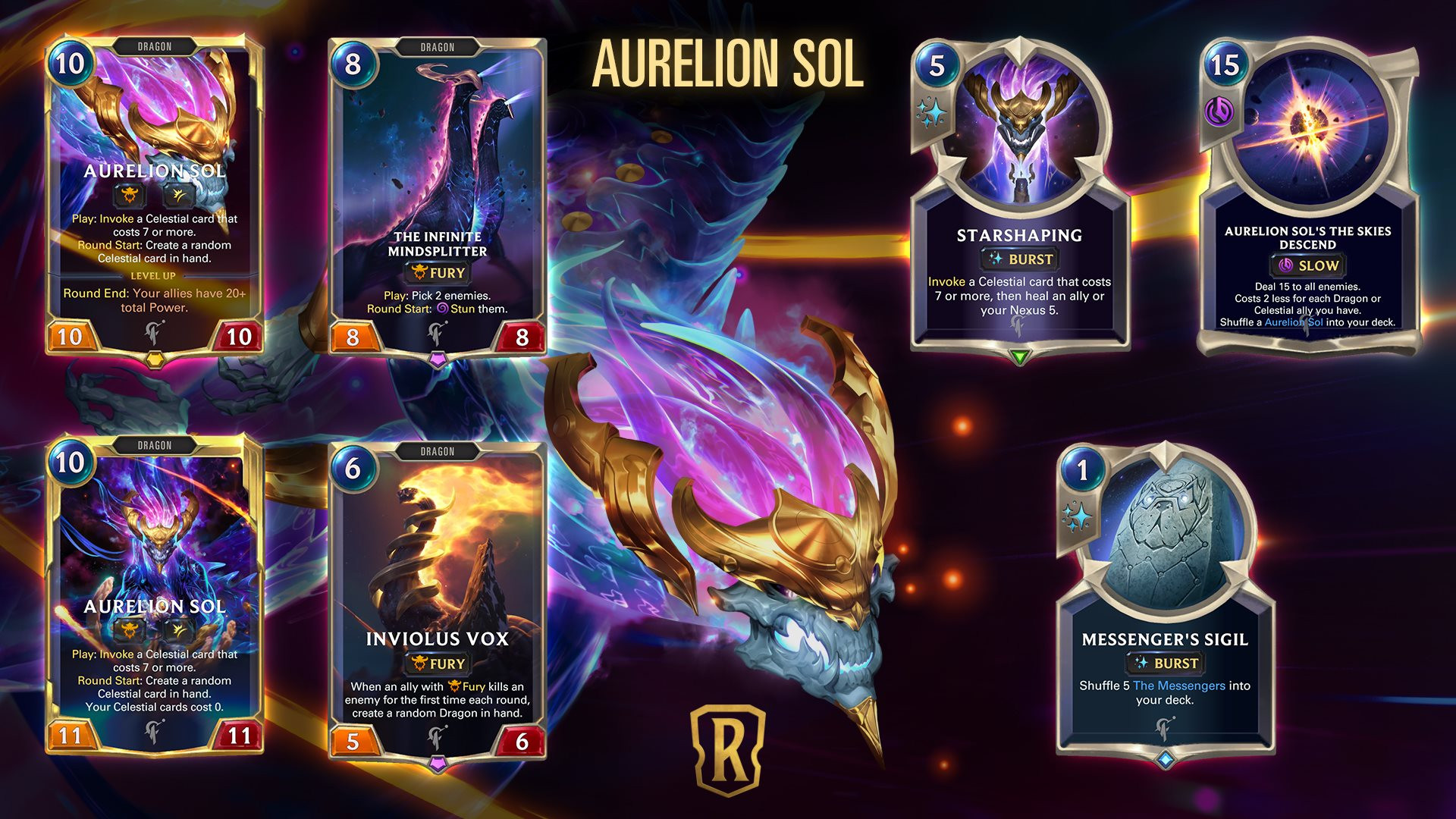
Aurelion Sol
![]() Aurelion Sol is a bulldozer. Huge, runs over everything in its way, but so incredibly slow. Before even considering including Aurelion Sol in a deck, we first have to ask ourselves: can we somehow survive until the late-game so we can spend our whole turn developing Aurelion Sol? At which point we also have to satisfy a board-centric level up condition which will, finally, allow us to swarm the board with all of the universe-crushing monsters we wish to have under our command. At first glance, the scenario seems tough to achieve. Besides, it seems quite overkill. After all, pushing the enemy Nexus to 0 health is just as effective as smashing it to smithereens at -50 health. Looking over at
Aurelion Sol is a bulldozer. Huge, runs over everything in its way, but so incredibly slow. Before even considering including Aurelion Sol in a deck, we first have to ask ourselves: can we somehow survive until the late-game so we can spend our whole turn developing Aurelion Sol? At which point we also have to satisfy a board-centric level up condition which will, finally, allow us to swarm the board with all of the universe-crushing monsters we wish to have under our command. At first glance, the scenario seems tough to achieve. Besides, it seems quite overkill. After all, pushing the enemy Nexus to 0 health is just as effective as smashing it to smithereens at -50 health. Looking over at ![]() Nautilus and his Deep Sea Monsters shows how similar their gameplan can be: achieve a convoluted level-up condition, play Champion, swarm the board with cheap but overstated creatures. What of his two keywords? Spellshield comes in very handy to avoid removal once played, however Fury is mostly useless on him. The ability to gain more value by "eating" the units they kill is likely to be irrelevant considering the value Aurelion Sol can generate every turn. Aurelion Sol's issue is that he's simply too damn expensive, and by turn 10 most games will already have been decided. If you somehow manage to get there, Aurelion Sol, unless leveled, will have no immediate effect on the board, providing additional value instead of much needed tempo. In the end, Aurelion Sol will be king of the greedy metagame, of this I have no doubt as the value he provides is unmatched. The best chance for Aurelion Sol to see play in a metagame where many deck archetypes are represented would be as 1 or 2 copies, acting as the ultimate top-end aimed to counter greedy control decks, though it will likely still have trouble against combo decks such as
Nautilus and his Deep Sea Monsters shows how similar their gameplan can be: achieve a convoluted level-up condition, play Champion, swarm the board with cheap but overstated creatures. What of his two keywords? Spellshield comes in very handy to avoid removal once played, however Fury is mostly useless on him. The ability to gain more value by "eating" the units they kill is likely to be irrelevant considering the value Aurelion Sol can generate every turn. Aurelion Sol's issue is that he's simply too damn expensive, and by turn 10 most games will already have been decided. If you somehow manage to get there, Aurelion Sol, unless leveled, will have no immediate effect on the board, providing additional value instead of much needed tempo. In the end, Aurelion Sol will be king of the greedy metagame, of this I have no doubt as the value he provides is unmatched. The best chance for Aurelion Sol to see play in a metagame where many deck archetypes are represented would be as 1 or 2 copies, acting as the ultimate top-end aimed to counter greedy control decks, though it will likely still have trouble against combo decks such as ![]() Ezreal/
Ezreal/![]() Karma, and the myriad of aggro decks all over ladder. There is another considerable opportunity in the form of
Karma, and the myriad of aggro decks all over ladder. There is another considerable opportunity in the form of ![]() Thresh, though it is rather unreliable. You thought Deep Sea Monsters was greedy? Check again.
Thresh, though it is rather unreliable. You thought Deep Sea Monsters was greedy? Check again.
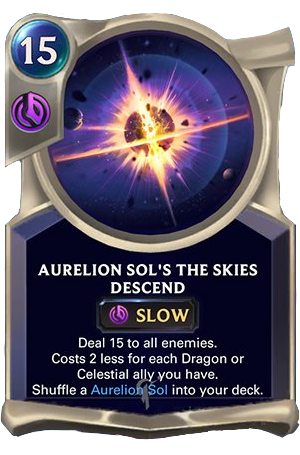
Aurelion Sol's The Skies Descend
In the same vein as Aurelion Sol, The Skies Descend is an over the top removal which can only be included in a board-centric deck revolving around Celestials, Dragons, or both. Let's compare it the other board wipe, ![]() The Ruination. First off, The Skies Descend preserve our own units and only requires three Celestials or Dragons to cost 9 mana, and can even go down to 3! The payoff is clearly much better than
The Ruination. First off, The Skies Descend preserve our own units and only requires three Celestials or Dragons to cost 9 mana, and can even go down to 3! The payoff is clearly much better than ![]() The Ruination, however it also presents a risk as it becomes unplayable if our board is wiped. The Skies Descend is a powerful card with incredible payoff but is also very susceptible to bricking. The high-risk, high-reward nature of The Skies Descend makes me wary, though it could still be an option for a deck that can refill its board with Celestials and Dragons quickly, turning the massive spell into an ever-looming threat that must be played around. Imagine a midrange deck aiming to swarm the board with Celestials and Dragons. Having a 3 to 7 mana board wipe sounds pretty good, however clunky it may first look, though of course getting that many Celestials or Dragons on board is going to be no easy feat, and may sadly relegate The Skies Descend to the "Win More" category.
The Ruination, however it also presents a risk as it becomes unplayable if our board is wiped. The Skies Descend is a powerful card with incredible payoff but is also very susceptible to bricking. The high-risk, high-reward nature of The Skies Descend makes me wary, though it could still be an option for a deck that can refill its board with Celestials and Dragons quickly, turning the massive spell into an ever-looming threat that must be played around. Imagine a midrange deck aiming to swarm the board with Celestials and Dragons. Having a 3 to 7 mana board wipe sounds pretty good, however clunky it may first look, though of course getting that many Celestials or Dragons on board is going to be no easy feat, and may sadly relegate The Skies Descend to the "Win More" category.
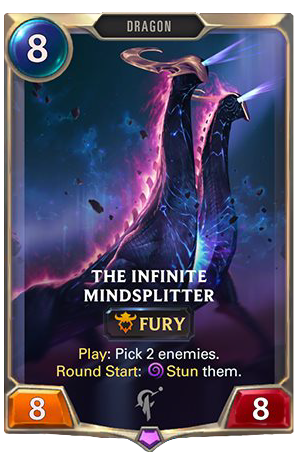
The Infinite Mindsplitter
Another high-risk high-reward card. While its stats are good, it fails at generating tempo immediately since the stuns only apply at the beginning of the next turn, leaving time for our opponent to either deal with the Infinite Mindsplitter, or develop more threats. It is also somewhat clunky, as the picked units could be disposed of by overflowing the board, using ![]() Glimpse Beyond, or
Glimpse Beyond, or ![]() Single Combat in order to get some value out of them. Inevitably, The Infinite Mindsplitter will be compared to
Single Combat in order to get some value out of them. Inevitably, The Infinite Mindsplitter will be compared to ![]() Yone, Windchaser, and for good reason, however their purpose are different. They obviously both have synergy with
Yone, Windchaser, and for good reason, however their purpose are different. They obviously both have synergy with ![]() Yasuo, but
Yasuo, but ![]() Yone, Windchaser is a fast, yet temporary stun, to gain tempo, while The Infinite Mindsplitter is a delayed, but potentially infinite stun, a pseudo-removal. While a powerful unit with much potential value, the Infinite Mindsplitter is too slow to become a staple of the region like
Yone, Windchaser is a fast, yet temporary stun, to gain tempo, while The Infinite Mindsplitter is a delayed, but potentially infinite stun, a pseudo-removal. While a powerful unit with much potential value, the Infinite Mindsplitter is too slow to become a staple of the region like ![]() Riptide Rex is in Bilgewater, though it could still see use in the right deck, but always with the caveat that such a slow card is incredibly hard to include when aggro is relevant in the metagame.
Riptide Rex is in Bilgewater, though it could still see use in the right deck, but always with the caveat that such a slow card is incredibly hard to include when aggro is relevant in the metagame.

Inviolus Vox
With a statline on the weaker side for a 6-drop, Inviolus Vox looks to empower its Fury-bearing companions to generate value rather than fighting by itself. Fury is a valuable keyword which can easily get out of hand following a few calculated trades, and Inviolus Vox wishes both to capitalize on the keyword and its Dragon tribe. A sturdy statline attached to a value-generating keyword and aura is sure to make Inviolus Vox a good choice for Dragon or Fury decks, though it is admittedly on the slow side, even for a value engine.
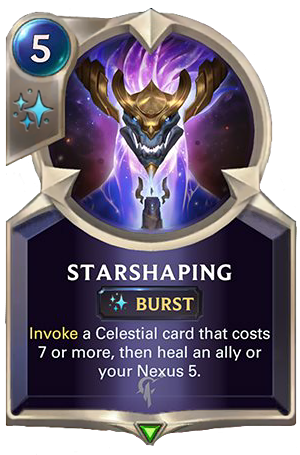
Starshaping
I can't help but feel that this card must be some sort of combo piece. The healing can be nice to stall but will not be enough to stave off aggression on its own, which leaves us with a 5 mana: "Invoke a 7+ cost Celestial". It is good value, certainly, but it also carries the same flaw as Aurelion Sol and his host of expensive cards: too slow! There is potential for spell or healing synergy, but currently Starshaping is simply too greedy to see much play beyond the Control Aurelion Sol archetype that will surely emerge, and even there is a stretch.
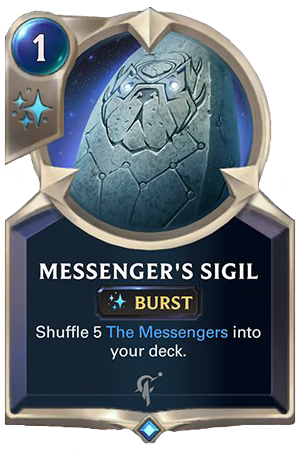
Messenger's Sigil
This, is one strange card. The Messenger itself is a 2/2 that draws a card when summoned, a fine investment for 2 mana. However shuffling five copies in our deck doesn't achieve anything of its own. First, we would need to actually draw one of these five copies. Then once we play it, the payoff is to... draw the card from our deck that we would have drawn instead if we hadn't shuffled Messengers in our deck? As you can see, Messenger's Sigil, is a strange card that does not provide much value, if at all, and in fact can easily end up clogging our deck, forcing us to spend the mana to get to the rest of our cards. There is obviously a missing element here, as tutors or effects that summon from deck could synergise well with Messenger's Sigil, or used in attrition-based decks aiming to thoroughly outvalue the enemy deck. Messenger's Sigil is clunky and I would avoid playing it as it falls prey to same issues as other deck-spawning cards like ![]() Counterfeit Copies or
Counterfeit Copies or ![]() Parade Electrorig, though admittedly it could gain some traction if more deck manipulation effects are introduced.
Parade Electrorig, though admittedly it could gain some traction if more deck manipulation effects are introduced.
Herald of Dragons
A very low statline for a 2-drop, Herald of Dragons is not meant to partake in the fighting, instead staying nice and cozy on the backline, helping to summon her more powerful Dragon friends. A Ramp option for Dragon decks, Herald of Dragons is risky to play, but if she not dealt with will reward her bearer with a strong acceleration into the midgame, unleashing powerful Dragons early and staying ahead of the curve. For now though, as long as ping damage spells like ![]() Make it Rain or
Make it Rain or ![]() Vile Feast are around, it will be hard for Herald of Dragons to find a comfortable home.
Vile Feast are around, it will be hard for Herald of Dragons to find a comfortable home.
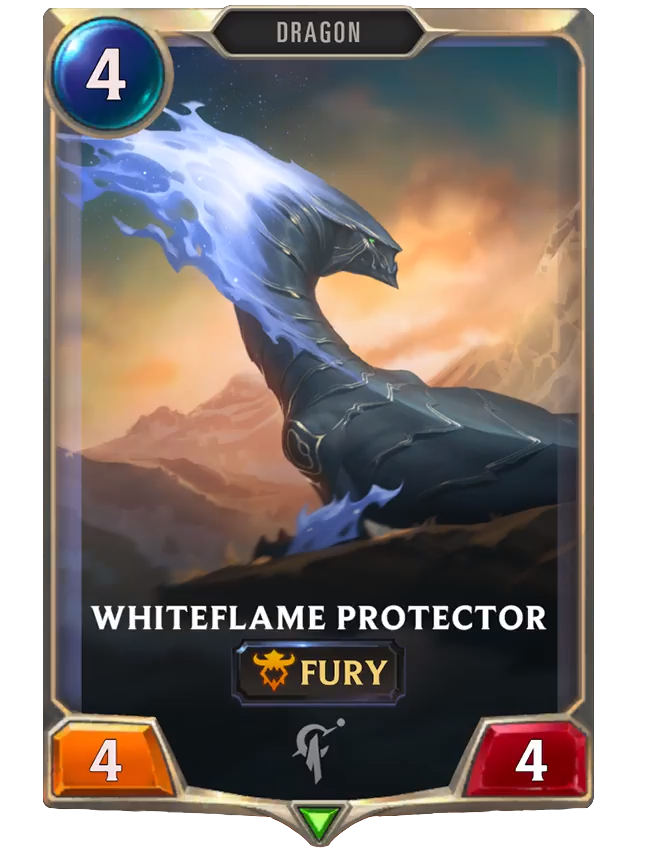
Whiteflame Protector
At 4 mana, 4/4 is a good enough statline, however Whiteflame Protector's Fury is designed for them to fight and survive, an unlikely proposition at this stage of the game. However if they do survive, they have the potential to keep growing, and paired with a few combat tricks or healing, could take over the game. Whiteflame Protector is a decent unit to include in a Dragon or Fury deck as it can grow if left unchecked, and is a great follow-up to a turn 2 Herald of Dragons, but will not make good use of their keyword without proper assistance.
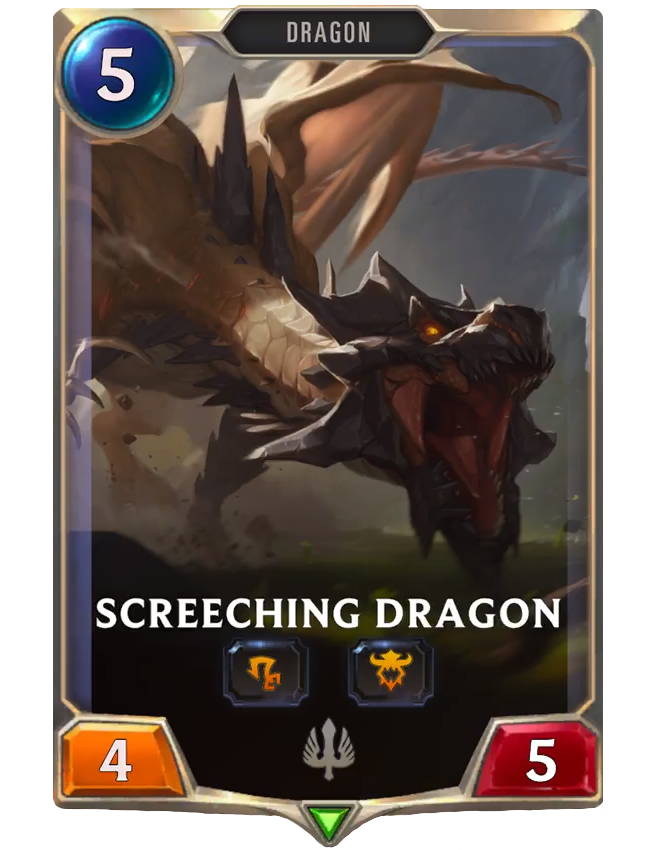
Screeching Dragon
Where Whiteflame Protector felt average, Screeching Dragon is here to remind us of the true might of Dragons. Challenger and Fury on a single unit is huge, as it is able to sweep whichever target is more advantageous and devour it for its tasty, tasty stats buff. Obviously pairs well with Herald of Dragons for a turn 4 play, but will still find its value by turn 5. Since Screeching Dragon is from Demacia, ![]() Remembrance is being empowered as a side effect, increasing both its power and variance. Overall, Screeching Dragon might not be a staple of Dragon Decks because of its Demacia restriction, but will still affirm itself as one of the better 5-drops in the region, and could in fact justify a Targon/Demacia pairing.
Remembrance is being empowered as a side effect, increasing both its power and variance. Overall, Screeching Dragon might not be a staple of Dragon Decks because of its Demacia restriction, but will still affirm itself as one of the better 5-drops in the region, and could in fact justify a Targon/Demacia pairing.
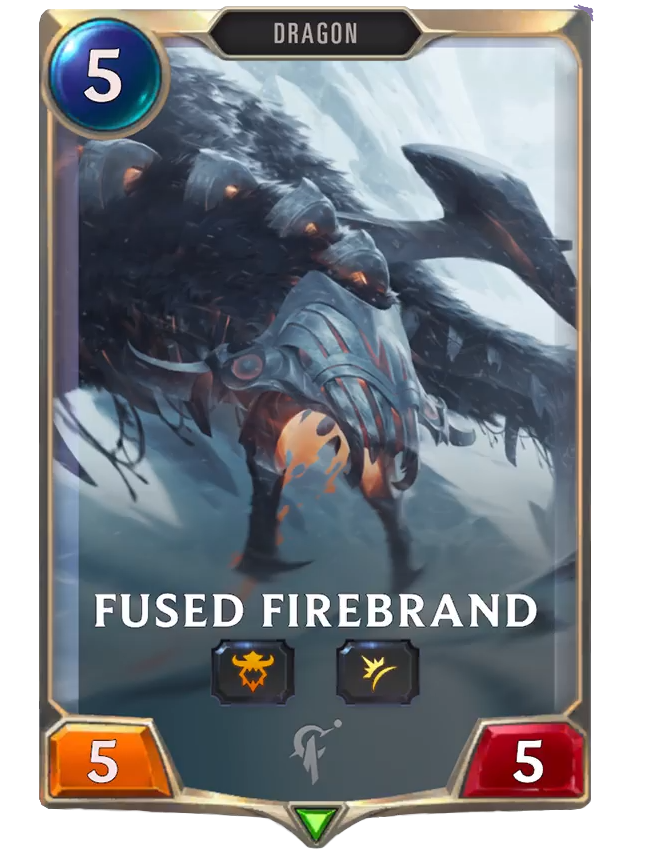
Fused Firebrand
With a more well-rounded statline than Screeching Dragon, Fused Firebrand suffers from a less broadly useful keyword than Challenger. While it will not be able to choose its targets in order to grow, the Spellshield is still a strong addition both against combat tricks and in preventing its removal. Fused Firebrand is not a staple but will still see play, especially if the metagame leans toward Control or Combo decks that thrive to stall the game through removal. As a footnote, both Fused Firebrand and Screeching Dragon are great recipients of the buff provided by Augur of the Old Ones.
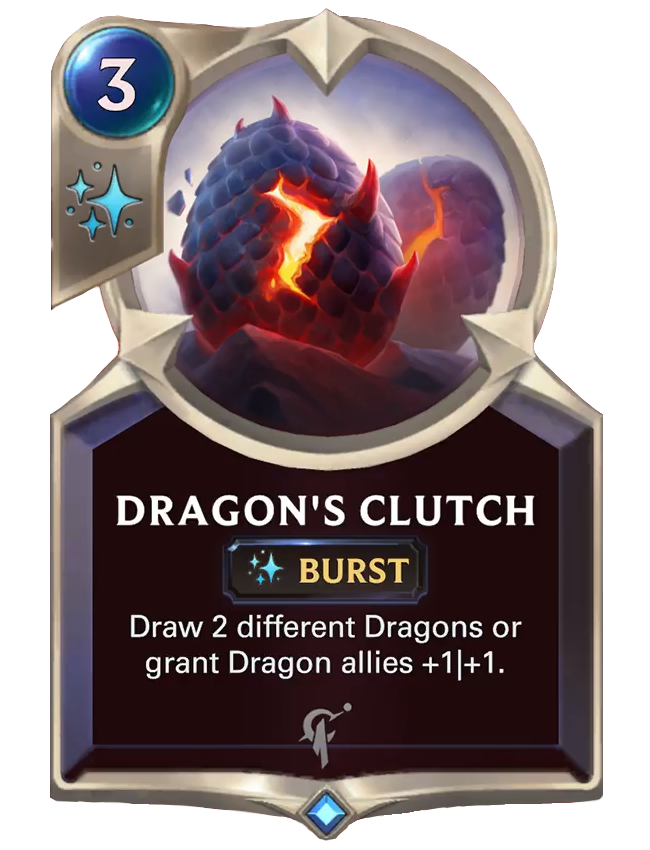
Dragon's Clutch
Giving off strong ![]() Deep Meditation vibes, Dragon's Clutch is an excellent value play. Drawing 2 different Dragons is easy enough to turn consistent, as we will be sure to only include Dragons we want to draw within our deck. It could also become a narrow Tutor instead, where we want to find a very specific and powerful Dragon like Aurelion Sol, though that would mean foregoing Dragon's Clutch's secondary ability to buff our board, discarding its welcome flexibility. It is a great value spell for any Dragon-centric archetype.
Deep Meditation vibes, Dragon's Clutch is an excellent value play. Drawing 2 different Dragons is easy enough to turn consistent, as we will be sure to only include Dragons we want to draw within our deck. It could also become a narrow Tutor instead, where we want to find a very specific and powerful Dragon like Aurelion Sol, though that would mean foregoing Dragon's Clutch's secondary ability to buff our board, discarding its welcome flexibility. It is a great value spell for any Dragon-centric archetype.

Keyword: Invoke
Units and spells with the Invoke keyword generate token spells and units from a pool of Celestial cards. I will not be reviewing each of the 23 Celestials one after the other as by design many of their effects are niche and none of them are supposed to be picked 100% of the time, instead representing a test of our adaptation skills. Invoke units, however, sometimes have restriction on which Celestials they have access to, and that is the key to evaluating their power. For reference, the list of all Celestial cards can be found just above, as it was put together by reddit user u/Sparksen.
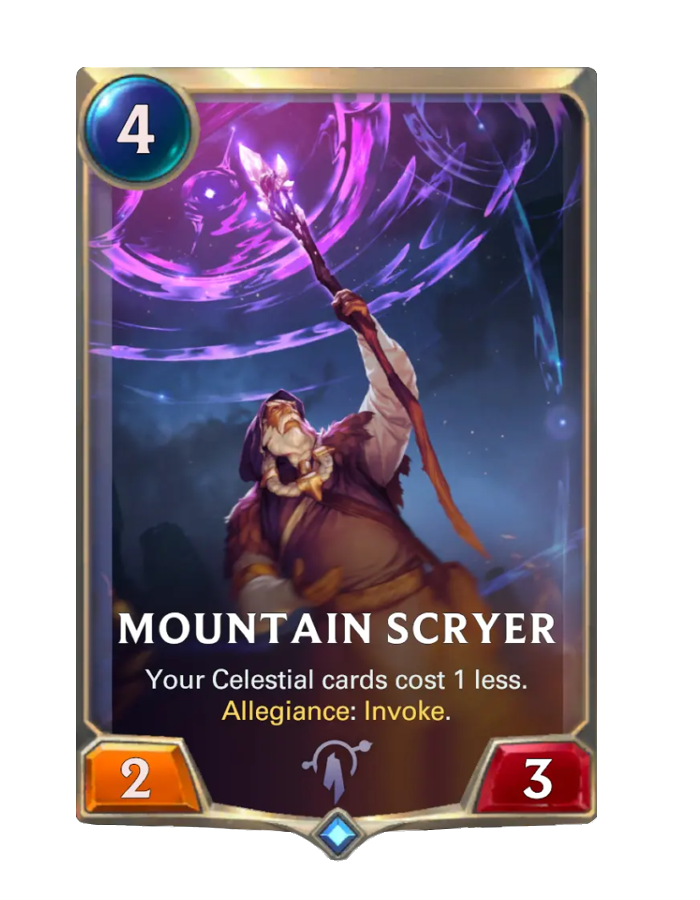
Mountain Scryer
Few allegiance cards are played as it incurs a heavy opportunity cost when building a deck. Several Allegiance cards were nerfed in the past, ![]() Vanguard Bannerman,
Vanguard Bannerman, ![]() Wraithcaller, and
Wraithcaller, and ![]() Basilisk Rider. They all force heavy deckbuilding restrictions in order to make their Allegiance trigger consistent, and Mountain Scryer will be no different. As a 4-drop for 2/3, he is obviously a value play in the same vein as Herald of Dragons, trying to facilitate the coming of the very Celestial cards he Invokes. Mountain Scryer imposes severe deckbuilding constraint and is a weak mid-game play for a deck that presumably wants to ramp up, and therefore must somehow survive long enough to achieve that. Some will point that
Basilisk Rider. They all force heavy deckbuilding restrictions in order to make their Allegiance trigger consistent, and Mountain Scryer will be no different. As a 4-drop for 2/3, he is obviously a value play in the same vein as Herald of Dragons, trying to facilitate the coming of the very Celestial cards he Invokes. Mountain Scryer imposes severe deckbuilding constraint and is a weak mid-game play for a deck that presumably wants to ramp up, and therefore must somehow survive long enough to achieve that. Some will point that ![]() Yordle Grifter is not not different in terms of stats, however that one is included less so for the Nabbed card, and more for the
Yordle Grifter is not not different in terms of stats, however that one is included less so for the Nabbed card, and more for the ![]() Warning Shot that is used to set up huge tempo plays like
Warning Shot that is used to set up huge tempo plays like ![]() Riptide Rex. I can see a place for Mountain Scryer in a dedicated Celestial deck though I have heavy doubts that such an archetype will ever be consistent enough to be competitive.
Riptide Rex. I can see a place for Mountain Scryer in a dedicated Celestial deck though I have heavy doubts that such an archetype will ever be consistent enough to be competitive.
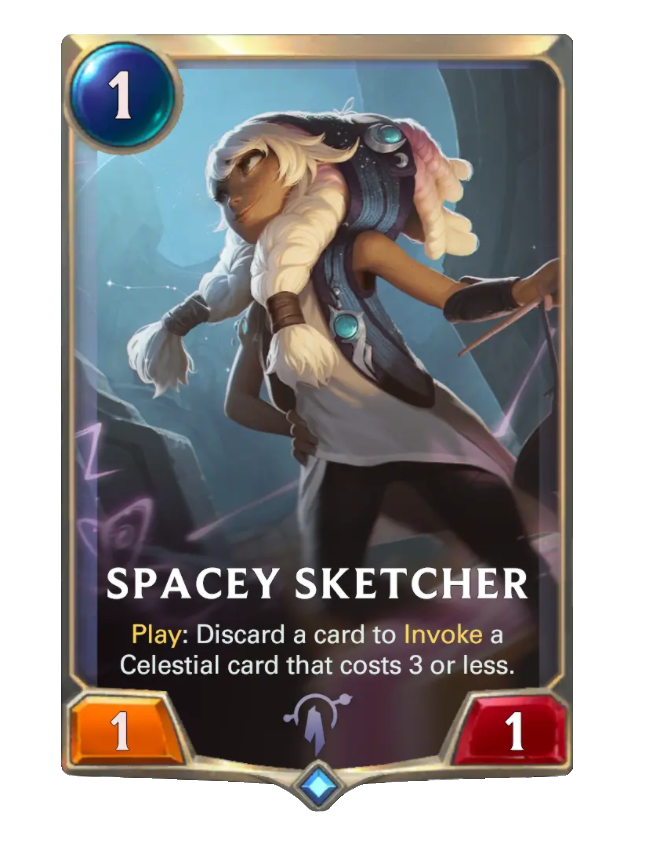
Spacey Sketcher
Spacey Sketcher is of little trading value, though she can at least defend against the many 1 health units that arrive on turn 1. Her weak stats are one downside, while the other comes in via the discard requirement, forcing us to generate a card of little value to discard, traditionally in the form of ![]() Chump Whump's
Chump Whump's ![]() Mushroom Clouds or
Mushroom Clouds or ![]() Draven's
Draven's ![]() Spinning Axe. In their absence, Spacey Sketcher could still make use of gems for cheap discard, and in a pinch could discard a bricked card to generate a useful cheap Celestial. Overall Spacey Sketcher is a versatile unit which will see play for its flexibility in the early game, as well as its value potential later on.
Spinning Axe. In their absence, Spacey Sketcher could still make use of gems for cheap discard, and in a pinch could discard a bricked card to generate a useful cheap Celestial. Overall Spacey Sketcher is a versatile unit which will see play for its flexibility in the early game, as well as its value potential later on.
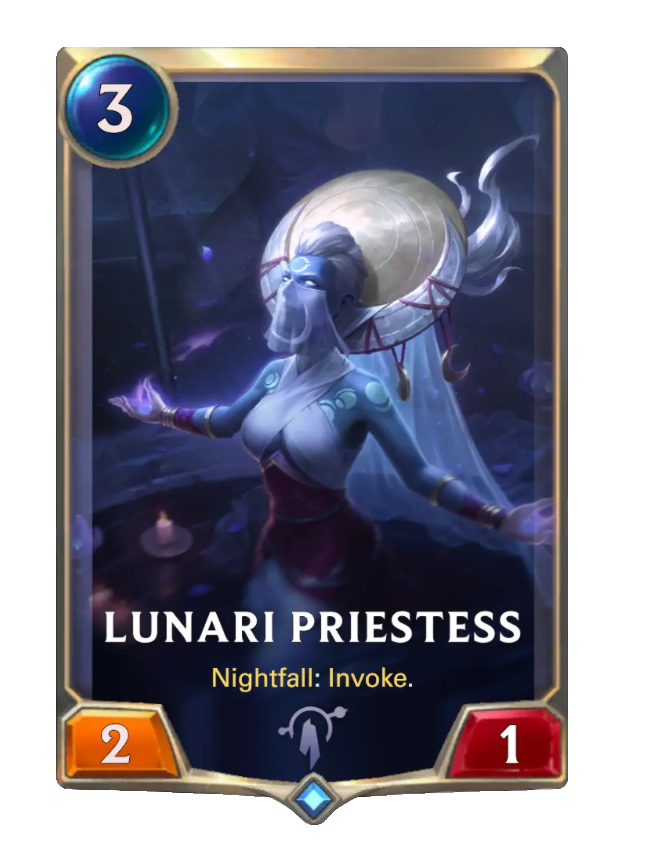
Lunari Priestess
There is much value to be gained from Lunari Princess' Invoke, however her variance is massive. Out of 23 cards, finding one that is immediately beneficial is unlikely, and coupled with the necessity to activate Nightfall, it results in a rather awkward card. Since we cannot plan around which card her Invoke is going to grant us, she is a worse version of Solari Priestess, and since they are both from Targon there is little reason to run the moon priestess over her sun-worshipping sister.
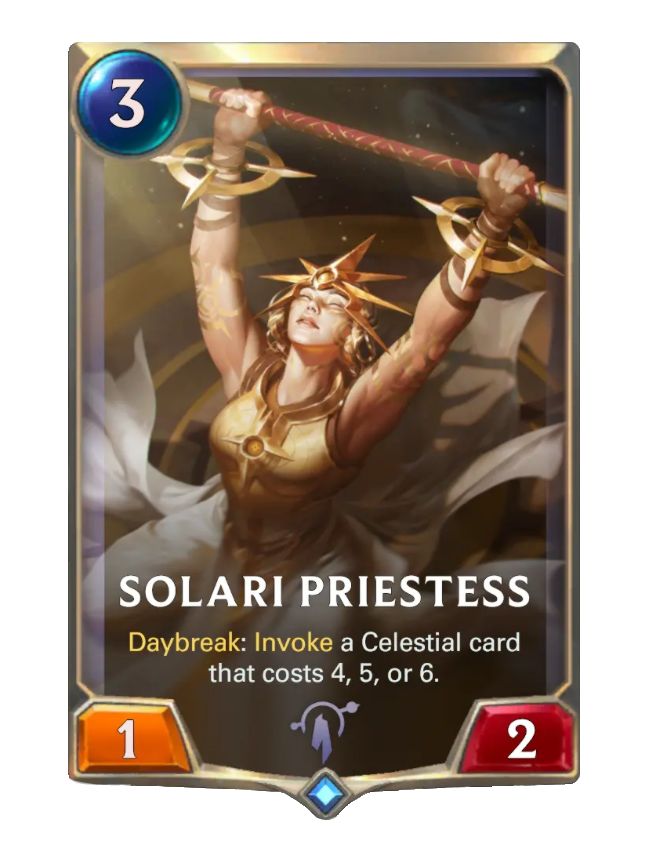
Solari Priestess
While Solari Priestess' Invoke effect is better and easier to build around since her Invoke is restrained to fewer Celestials, her statline is quite awkward. With only 1 attack, she cannot gain much value from trading, while at least Lunari Priestess can use her 2 attack to trade against an attacking unit. Still, Solari Priestess' more controlled effect puts her on top as one of the better Invoke cards.
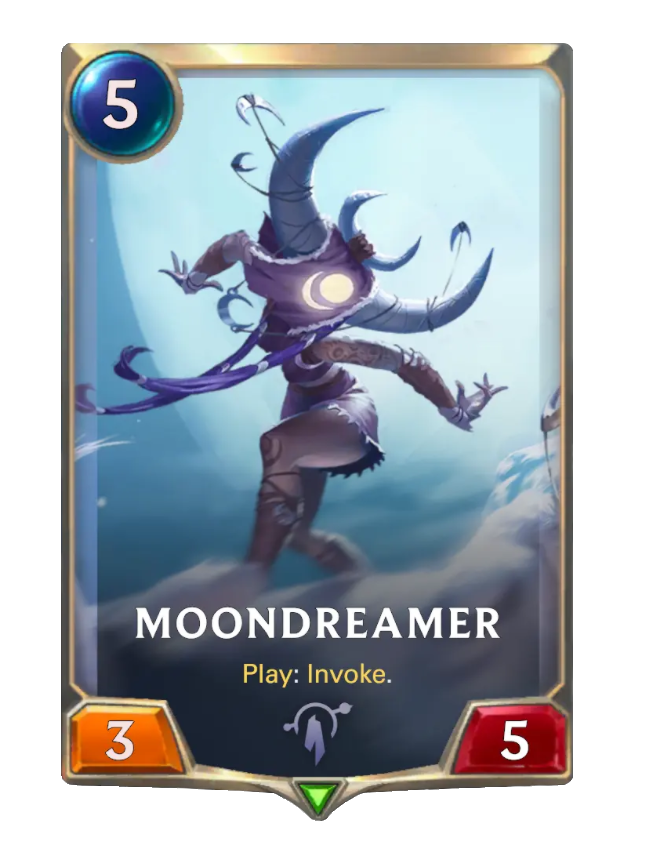
Moondreamer
Along with Solari Priestess, Moondreamer is one of the better Invoke units. Her stats are obviously lower than other 5-drops, but the potential for value is great. Still, like other Invoke units, the variance on which Celestial card will be offered is too large for to be of consistent use, unless in a deck that is so greedy that it does not mind any of the Celestial options.

Behold the Infinite
Cheap but with very high variance, Behold the Infinite has potential with spell synergy but is otherwise in line with the rest of the Invoke cards. It is still unique since its Burst speed allows the creation and immediate play of a Celestial which are all Slow. Overall, like most other Invoke cards, outside of a Celestial archetype Behold the Infinite falls short because of its inconsistency.
Verdict
This last set of reveals is certainly flavourful, though a lot of its powers fall short, not because of a lack of power but too much of it. Aurelion Sol and many of his followers are simply too expensive and slow to be viable against most decks. Their payoff is insane, true, but there is such a thing as too much payoff if it means that by association the cost is also too high. The Dragon package looks quite solid for a midrange deck, but currently is lacking Tribe support. Finally, the Invoke/Celestial package, with 23 Celestials to choose from is going to be very inconsistent, with the exception of Spacey Sketcher and Solari Priestess. Still, Aurelion Sol may periodically make apperances in the meta as it becomes too slow, but otherwise will be kept in check by aggro.

Author
Asher
Card game enthusiast since childhood, and Top Master player for LoR, Asher has played as many CCGs as he could lay his hands on which kickstarted his competitive streak. Achieving high ranks in Hearthstone, Duelyst, and TES: Legends, his goal is now to do the same in Legends of Runeterra by competing in all possible tournaments. With a drive to always improve, Asher is looking to brew the best decks and help new and experienced players alike.






